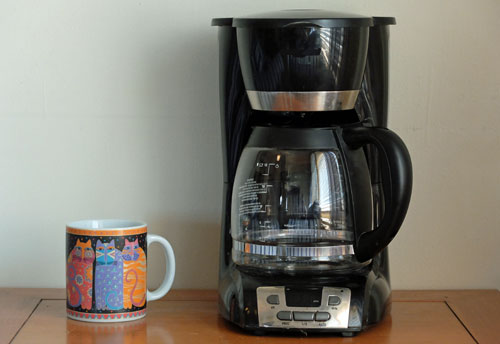The plastic taste in new coffee makers – Just a bad taste, or toxic too?
Based on the feedback to this site alone, it seems thousands of people are buying new coffee makers, and are then horrified by plastic taste they notice with the first few cups of coffee they brew.
In many cases, people feel so upset, and concerned, they simply return the brewers to the place where they bought them.
I have had the exact same experience myself, with several coffee makers over the years. And it doesn’t seem you can point your finger any one or two manufacturers. This problem seems to be common to pretty much any coffee maker that includes plastic parts.
What causes this bad taste? Chemicals leaching out of the plastic and into your coffee.
Worse still, the main culprits are endocrine disruptors, which have a variety of adverse effects on our health.
Bisphenol-A, also known as BPA, and a class of chemicals known as Phthalates both leach out of the plastics in coffee makers.
Bisphenol-A is used in the manufacture of hard plastics. If the water reservoir on your coffee maker is marked with the recycling number 7, it likely contains BPA.
As mentioned, BPA is a hormone disruptor. In fact, BPA was first used as a synthetic estrogen in the 1930s. That’s right, the plastics in your home are being hardened with synthetic estrogen.
The problem is, the BPA does not all stay bound within the plastic. Some of it leaches out. So you, me and our kids are ingesting estrogen from the plastics in our homes.
The other hormone disruptor is a class of chemicals known as phthalates. Phthalates are more of a problem with your coffee maker, because they are more likely to be leached out by the hot water inside of your brewer.
Phthalates are used in the making of PVC plastic to make it soft and bendy. Yes, the pipes and tubes inside your coffee maker are likely made with PVC.
In fact, most of that horrible plastic taste likely comes from these PVC tubes, and not from the polycarbonate water reservoir.
Recently I purchased a new brewer because the old one was bust. Same brewer, same model. Thinking I was being smart, I used the water reservoir from the old brewer, to avoid having BPA leach into the coffee. But switching to the old reservoir made no difference at all to that awful plastic taste when I began brewing. I had to run water and vinegar through the brewer 20 times before the taste disappeared.
BTW, you are probably already familiar with phthalates. When you buy a new car, that “new car smell” is the stink of phthalates off-gassing from the plastics inside the vehicle.
Now for the bad news…
These chemicals leaching out from your new coffee maker do more than just make the coffee taste foul, they are also bad for your health.
Endocrine disruptors can upset normal hormonal balance in our bodies, stimulate the growth and development of cancers (breast, uterine, prostate), impair fertility, and disrupt pregnancy.
Other illnesses now being associated with exposure to phthalates in particular include heart disease, behavioral problems in children and asthma.
Scary stuff.
Getting rid of that bad taste.
Do as I did. Mix vinegar with water, half and half, and then repeatedly run it through your brewer, with a fresh mix for each brewing cycle. You may have to do this 10 or 20 times before you can brew a decent tasting cup of coffee.
But even with the bad taste gone, what about the ongoing ingestion of these chemicals as you continue to use your brewer? Just because you can no longer taste them, doesn’t mean that they don’t continue to leach into your coffee each day.
The safe way forward.
The only safe option is to use coffee makers that don’t use plastics. Or, at least, where any plastics used don’t come into contact with the hot water or coffee.
This pretty much rules out every drip brewer and single serve coffee maker. In fact, you are left with a list of traditional and simpler brewing systems, like the French press, percolator and ceramic pour-over filter cones. There are also some glass-only options like the Chemex.
You lose a lot of the convenience of the more automated brewing systems, but you will benefit from keeping your body free from these toxic chemicals.
Read more of my coffee opinion posts.
In these posts I share my thoughts and opinions on various aspects of gourmet coffee – sometimes thoughtful, and sometimes more lighthearted. Find my posts here...
Additional information that might interest you:
Coffee from our new coffee maker tastes bad.
Are mold and bacteria growing inside my coffee maker?
Is There an Automatic Drip Coffee Maker with no plastic parts?
About the author: Nick Usborne, aka Coffee Detective, is a writer and long-time coffee enthusiast. Read more…
Before you go, sign up to receive the Coffee Detective Newsletter...
Sign up for occasional newsletters about the best coffees and brewing equipment. Plus special updates from the Coffee Detective Coffee Store…





